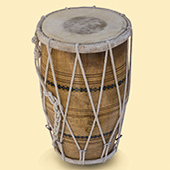Design Resource
Dholak Making - Ahmedabad, Gujarat
Folk Drum Player
by
Prof. Bibhudutta Baral and Sandhya B.
The Dholak is a well-known instrument and it gives out the best positive energy that one can receive through its rhythms, anyone who hears would want to shake a bit, move and groove to the beats. The making of Dholak is widely seen in northern parts of India. Ahmedabad in Gujarat is one of the places where one can witness the making of it. The seasoned wood is cut and shaped to a barrel shape with an increased diameter at one side leaving both ends open and hollow. It is polished to get a nice glossy brunet tone. The open ends are filed and shaped to fix the heads later. Once the polish is done, according to the customers’ order the Dholak is built with screw-turn buckle tensioning or is tied with lace tying method.
In Screw-turn buckle tensioning, barrel shaped wooden piece is pierced with holes evenly on both side. The holes are made circling the openings inches away from them. Dholak sockets are fixed to the holes made. The processed skin or leather is soaked in water for minutes in water. Strips of bamboo stick is curled to the diameters of barrel shaped wooden openings (the body part of Dholak) and tied. The leather is cut to the sizes of rings made and tucked in with help of a thin wooden stick. Once the leather is neatly stuck to the respective rings, to the right head (the one with a bigger diameter) mostly, Dholak masala is applied – a mixture of fine sand, grease and iron fillings. It is applied to a small part at the center of the ring. The rings wrapped with leather sheet are called as Dholak heads and it is used to cover the wooden piece (the body part of Dholak) on both sides. One side of the Dholak is covered with Dholak head with mixture (Dholak masala) facing the mixture reverse. The head is locked with help of Dholak hooks. The hooks help to firmly fix the head and is screwed in the respective sockets. The heads are tuned by tightening the bolts or the hooks. Only an experienced person can easily fix the tunes evenly on the smaller head. The bam side or the bigger head can be tuned by tightening the bolts. In case of lace tieing method, the heads are attached to the shell by tieing it with rope initially. A cotton rope of good length is put to the needle and the heads are sewed. Threads are pass from Small metal rings of inch’s diameter are attached while tieing the rope to tighten the rope when needed. This way the heads are attached to the shell and finally tuning is done. The dholak must be saved from moisture as it can spoil the skin of the heads and also contact of sharp objects must be avoided. The dholak can be covered when not in use and the ropes must be loosened after playing otherwise it might get ruined by overstraining.
Flow Chart:















